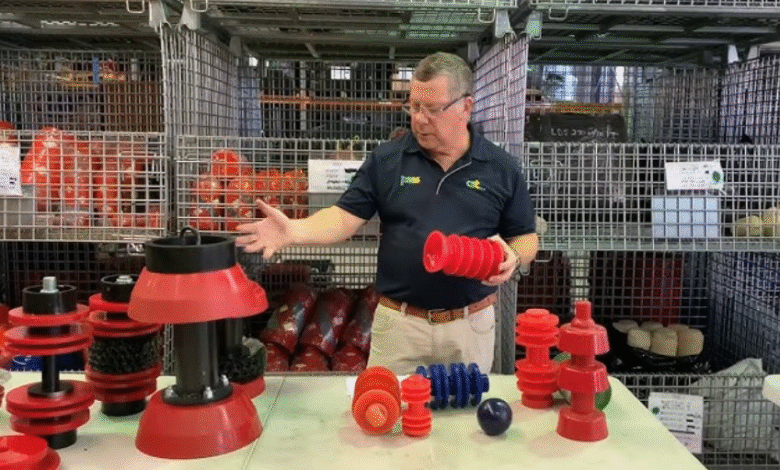The Role of the Pipeline Pig in Modern Flow Assurance and Maintenance

In industries that rely on pipeline transportation—be it oil, gas, water, chemicals, or food products—keeping pipelines clean, efficient, and safe is a constant challenge. One of the most innovative yet often underappreciated tools used for maintaining these vital flow networks is the pipeline pig.
Though the name may sound humorous, the pipeline pig is a serious piece of engineering that plays a critical role in pipeline maintenance, inspection, and efficiency optimization. Over the decades, this technology has evolved into a sophisticated system used across a wide range of sectors, from petrochemicals to beverages.
This article explores the concept of the pipeline pig, its history, various types, modern uses, and the growing relevance of this tool in today’s industrial environments.
What Is a Pipeline Pig?
A pipeline pig is a device inserted into a pipeline to perform tasks such as cleaning, inspecting, separating products, or maintaining flow efficiency. These pigs travel along the pipeline, propelled by the flow of the product itself or by compressed gas or liquid. As they move, they interact with the internal surface of the pipeline, either removing debris, measuring internal conditions, or pushing materials along.
The term “pig” is believed to have originated from early versions made of straw and wire, which made a squealing noise as they traveled through the pipe. Modern pigs, however, are made from materials such as polyurethane, foam, or metal, and are engineered to suit specific applications.
See also: Bending in Sheet Metal: Techniques, Applications, and Challenges
The Purpose of Pipeline Pigging
The fundamental objective of pipeline pigging is to maintain uninterrupted, efficient, and safe pipeline operation. Over time, pipelines accumulate residues such as scale, wax, sand, or even biofilm, depending on the transported medium. These deposits can reduce flow efficiency, increase pressure drops, and even cause blockages or corrosion.
By using a pipeline pig, operators can:
- Clean the interior of the pipe
- Separate different batches of fluids
- Displace product from the pipeline
- Detect corrosion or deformation
- Reduce product waste during transfers
- Prepare the line for maintenance or inspection
Pigging is often part of a scheduled maintenance program, but it can also be deployed in emergency situations, such as when flow slows due to a suspected blockage.
Types of Pipeline Pigs
There are several different types of pipeline pigs, each suited for specific tasks. Choosing the right pig is essential for ensuring efficient operation without damaging the pipeline.
1. Cleaning Pigs
These are the most common type and are used to remove debris, scale, or wax from the pipeline. They often have brushes, blades, or abrasive surfaces.
2. Foam Pigs
Made from flexible foam, these are ideal for pipelines with sharp bends or irregular shapes. They are lightweight and can be used in low-pressure systems.
3. Batching Pigs
These pigs separate different products in multiproduct pipelines, such as in oil or chemical transportation lines, ensuring no mixing occurs.
4. Inspection Pigs (Smart Pigs)
These technologically advanced pigs are equipped with sensors and data recorders. They collect information about pipeline thickness, corrosion, dents, and even cracks.
5. Spherical Pigs
Primarily used for flow assurance and liquid removal, especially in gas pipelines.
Each pipeline pig must be compatible with the pipeline’s size, pressure, fluid type, and other operating parameters.
Key Applications of Pipeline Pigs
✅ Oil and Gas Industry
The oil and gas sector is perhaps the most well-known user of pipeline pigs. These tools are essential for:
- Preventing buildup of wax and scale
- Managing flow assurance in offshore pipelines
- Separating different hydrocarbon products in the same line
- Detecting pipeline integrity issues before they become critical
Pigging can be done in live pipelines without stopping production, minimizing downtime and costs.
✅ Chemical and Petrochemical Processing
Chemical plants use pigs to clean pipelines between batches or transfers. This prevents cross-contamination and ensures that pipelines remain in optimal condition.
✅ Food and Beverage Manufacturing
In hygienic applications, pigs help to recover expensive products like sauces, yogurt, or syrups that would otherwise be wasted. They also reduce the need for extensive cleaning, water, and chemicals.
✅ Water and Wastewater Systems
Utility companies use pipeline pigs to maintain flow in water lines, remove sediment buildup, and prepare pipes for lining or maintenance.
How a Pipeline Pig Operates
A pigging operation typically involves three stages:
- Launching – The pig is inserted into the pipeline via a pig launcher. Once sealed, pressure (usually from air, gas, or fluid) is applied to push the pig forward.
- Traveling – The pig moves through the pipeline, performing its task—whether that’s cleaning, displacing, or inspecting.
- Receiving – The pig is collected at the end of the pipeline at the pig receiver, where data can be retrieved or the pig is cleaned and reused.
Safety protocols are critical during pigging operations. Valves must be properly operated, pressure controlled, and operators trained to avoid hazards such as pressure buildup or explosive decompression.
Advantages of Using Pipeline Pigs
The benefits of incorporating pigging into pipeline management are significant:
- Enhanced Operational Efficiency: Clean pipelines reduce friction and energy loss, improving pump performance.
- Product Recovery: In industries like food and chemicals, pigs help recover high-value product from the line.
- Reduced Contamination Risk: Batch separation ensures product integrity.
- Pipeline Integrity: Inspection pigs help detect faults early, reducing the risk of leaks, spills, or environmental hazards.
- Lower Maintenance Costs: Regular cleaning minimizes the need for emergency repairs or line replacement.
Conclusion
The pipeline pig may be a small device, but its impact on industrial efficiency, safety, and sustainability is massive. From ensuring product purity in food manufacturing to inspecting subsea oil pipelines for corrosion, this simple tool carries out tasks that would otherwise require costly shutdowns or extensive manual labor.
As industries grow and infrastructure ages, pigging systems offer a proactive and intelligent approach to pipeline management. Whether you’re in petrochemicals or paint, considering the integration of a pipeline pig into your process is not just smart—it’s essential for long-term success.





